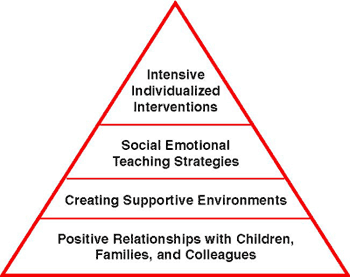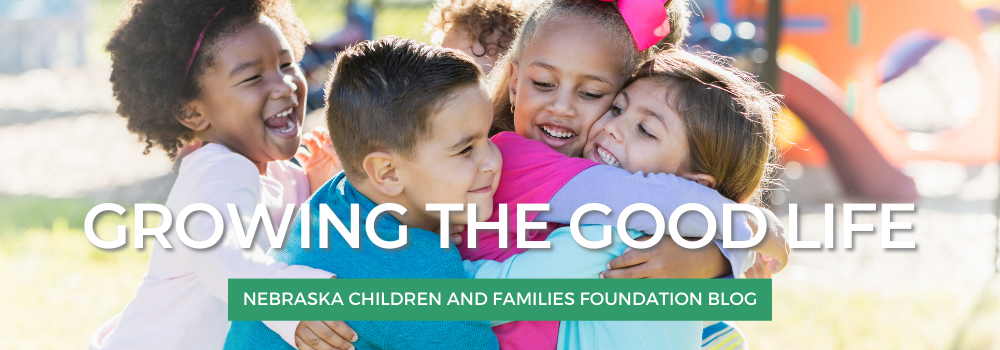By Lynne Brehm, Statewide Coordinator, Rooted in Relationships
Flash cards and boot camps and Baby Einstein, oh my! When I mention the idea of school readiness, most parents envision training their kids up to be reading Tolstoy and building robots by the time they enroll at age 5. And it’s no wonder — parents are getting conflicting messages that can lead to high anxiety about expectations.
Relax. That is not at all what school readiness is.
School readiness has been achieved when the child has the social-emotional competency needed for success.
That’s right . . . it’s about social-emotional development. Social-emotional development is the developing capacity of the young child to:
- Experience, regulate and express emotions
- Form close and secure relationships
- Explore their environment and learn
Healthy social-emotional development occurs within a caregiving environment that includes family, community and cultural expectations.
A socially and emotionally prepared 5-year-old:
- Can follow developmentally appropriate directions
- Does not disrupt the class
- Can play cooperatively with others
- Knows how to communicate thoughts and needs
- Is curious and enthusiastic about new activities
- Regulates emotions under most circumstances
- Forms close and secure relationships
That’s the core of it. Of course, the child must be well fed, well rested and otherwise healthy as well to be ready to learn. These skills come along with those vital executive functions we’ve been talking about. If this all sounds like it’s too simple, just imagine a child who did not have these characteristics. What would learning look like for that child? How would the classroom environment be affected?
A child who is hungry or has had too little sleep can’t pay attention.
A child with little skill at self regulating cannot persist at a task, follow instructions, play well with others or suppress outbursts.
A child who has no interest in new experiences because he is distracted by issues at home or other stressors will find little inspiration in a classroom, and little energy to learn.
And a child who doesn’t know how to form and maintain relationships will be lonely and unhappy.
For many families, social-emotional school readiness is a challenge.
As many as 40% of children enter kindergarten lacking one or more of these critical social-emotional skills. About 10% of kindergartners exhibit challenging behaviors that disrupt the class, cause problems with other children or necessitate intensive interventions. And for 65% of the children identified as having emotional or behavior disorders will drop out of school.
We know that dropping out of school often leads to poor job outcomes, limited income, and patterns of failure that may persist into adulthood, including unplanned pregnancies and criminal activity. If the ability to form and sustain healthy relationships is not formed during those early years, it is much harder later and adults may struggle to attach with their partners and children….and the cycle continues.
This is one of those ounce-of-prevention moments.
From a family perspective, paying more attention to how our very young children are developing emotionally and socially than we pay to trying to make them the smartest kid on the block is the best course of action. From a systems perspective, focusing on the social and emotional development of those children most at risk will improve their outcomes, our classrooms and our communities.
Here’s what we need to do:
- Prevent Adverse Childhood Experiences – Infuse families and communities with the protective factors they need to ensure that the adverse childhood experiences that can derail social-emotional development don’t happen. And when ACEs do occur, we must provide immediate support to mitigate the toxic stress that can result. We can all do this. In schools, we can provide to support to families we see struggling. We can reach out to our neighbors and act as informal support to those who need help. We can support home visitation and early learning programs that are proven to get results.
- Teach parents to engage and attach – Home visitation programs like those in Sixpence communities work. They provide parents a powerful set of skills to engage with their children, understand serve-and-return interactions, and work for the better social-emotional development of their babies. Most parents want what’s best for their children . . . but many don’t know how to do it. Parenting is a skill like anything else, and skills are learned from good teachers.
- Focus on early childhood caregivers and environments – Preparing early childhood educators to build healthy relationships with young children and foster environments that are developmentally geared to social-emotional learning are fundamental practices that will help ensure that most young children reach their social-emotional milestones.

- Plan social emotional support and advanced interventions for pre-schoolers who need additional assistance – For those children who require more individual, intentional supports, early childhood educators should be well versed in the resources available so they can recommend next actions. Without a plan for interventions, we will continue to see very young children being expelled from preschool programs for behavioral issues.
The thing to remember is this: without these base social-emotional skills in place, all the flash cards and kindergarten boot camps in the world won’t matter. Let’s engage with our kids, build secure attachments and form the necessary relationships at home.. In our early childhood programs, let’s focus energy on that critical brain development. The result will be greater school success and more positive life outcomes.

Another GREAT blog post! Simple. Easy to absorb. Nice work, ladies!
Lynne, I love your statement that “School Readiness is not what you think it is”! So true, and often misunderstood.
I wish you would have included a statement that children with disabilities should not be excluded or “held back” from kindergarten as their social emotional growth will occur in that setting to the greatest extent possible.
When we exclude or hold those children back, we are shortening the amount of time they will have for transition planning from age 18 to 21. We know there will always be a small percentage of children who will not meet the social emotional competencies you described above, but will demonstrate progress with special education supports.
Thank you.
Good point, Mary and Patty. Perhaps a future post could deal with this topic specifically. Since this post dealt more with the definition of readiness overall, and wasn’t meant to address special needs, it would make sense to cover that in a future post. Thanks for the feedback!
This was so encouraging to read! I just posted about School Readiness on my blog and came across yours! Thanks for a great read! http://www.athomewithdot.blogspot.com
Thank you for the kind words! Can’t wait to read your post as well.
Would you grant permission to me to print this and hand it out at Kindergarten roundup?
Yes, please do!
Thanks, so are we!